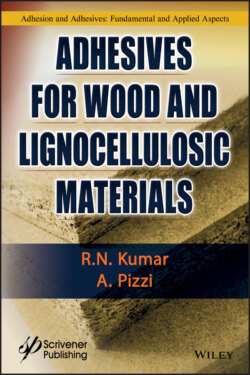Читать книгу Adhesives for Wood and Lignocellulosic Materials - R. N. Kumar - Страница 57
2.5 Electronic Theory
ОглавлениеThis theory was mainly promoted by Deryaguin [14–16]. If the adhesive and the substrate have different electronic band structures, there is likely to be electron transfer on contact between the two surfaces. This results in the promotion of a double layer of electrical charges at the adhesive substrate interface. Electrostatic forces are formed at the adhesive–adherent interface. This accounts for the resistance to separation. This theory gathers support from the fact that electrical discharges have been noticed when an adhesive is peeled from a substrate. Electrostatic adhesion is regarded as a dominant factor in biological cell adhesion and particle adhesion. No application of this theory to wood appears possible.
The electronic theory
Depends on material properties that allow electron transfer across the interface
Requires intimate contact/smooth surfaces
Interactions are very weak and rather insignificant
Mechanism is not important for wood substrates
